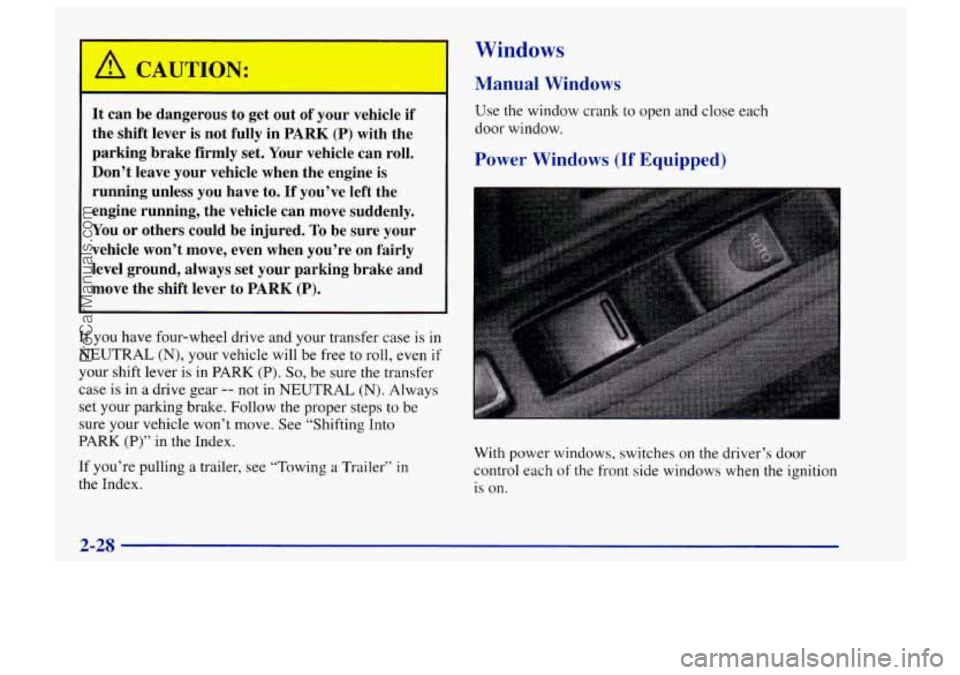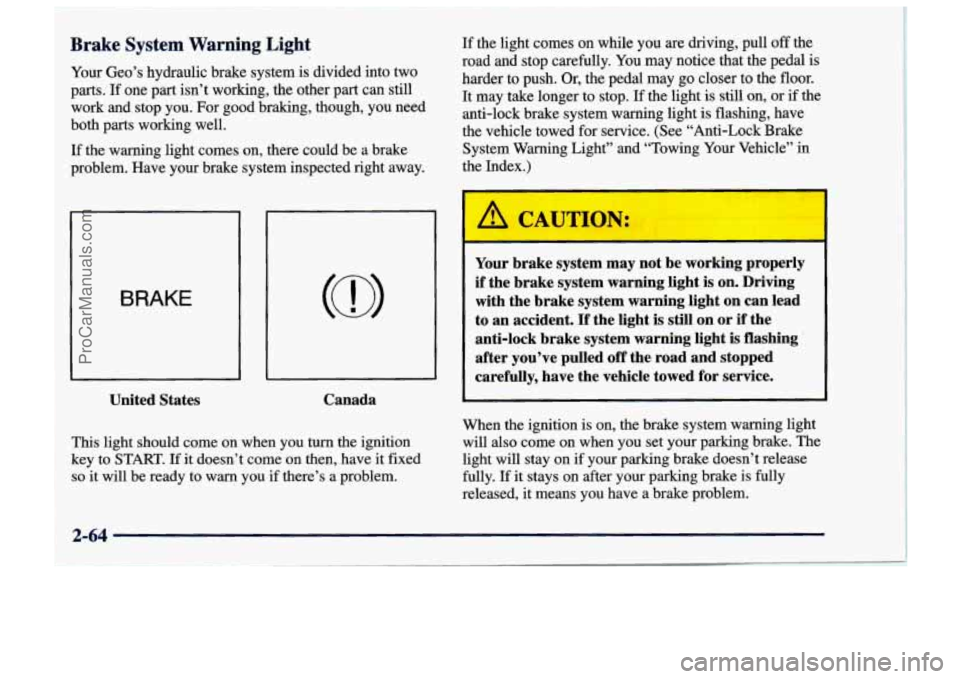Page 61 of 388

New Vehicle “Break-In” 1
NOTICE:
Your modern Geo doesn’t need an elaborate
“break-in.” But it will perform better in the long
run if you follow these guidelines:
0
0
0
0
Keep your speed at 55 mph (88 km/h) or
less for the first
500 miles (805 km).
Don’t drive at any one speed
-- fast or
slow
-- for the first 500 miles (805 km).
Don’t make full-throttle starts.
Avoid making hard stops for the first
200 miles (322 km) or so. During this time
your new brake linings aren’t yet broken
in. Hard stops
with new linings can mean
premature wear and earlier replacement.
Follow this breaking-in guideline every
time you get new brake linings.
Don’t tow
a trailer during break-in.
See “Towing
a Trailer” in the Index for
more information.
[gnition Positions
With the key in the ignition
switch, you can turn the
switch
to four positions.
LOCK (A): The only position in which you can remove
the key. This locks your steering wheel, ignition and
automatic transmission.
If you have an automatic transmission, the ignition
switch can’t be turned to
LOCK unless the shift lever is
in the PARK (P) position.
2-7
I
ProCarManuals.com
Page 64 of 388
NOTICE:
Your engine is designed to work with the
electronics
in your vehicle. If you add electrical
parts or accessories, you could change the
way
the engine operates. Before adding electrical
equipment, check with your dealer.
If you don’t,
your engine might not perform properly.
If you ever have to have your vehicle towed, see
the part
of this manual that tells how to do it
without damaging your vehicle. See “Towing
Your Vehicle” in the Index.
Automatic Transmission Operation
There are several different positions for your shift lever.
PARK (P): This locks your rear wheels. It’s the best
position
to use when you start your engine because your
vehicle can’t move easily.
2-10
ProCarManuals.com
Page 65 of 388

1 A CAUJON:
It is dangerous to get out of your vehicle if the
shift lever is not fully in PARK
(P) with the
parking brake firmly set. Your vehicle can roll.
Don’t leave your vehicle when the engine is
running unless you have to.
If you have left the
engine running, the vehicle can move suddenly.
You or others could be injured.
To be sure your
vehicle won’t move, even when you’re on fairly
level ground, always set your parking brake and
move the shift lever to PARK
(P).
If you have four-wheel drive, your vehicle will
be free to roll
-- even if your shift lever is in
PARK
(P) -- if your transfer case is in
NEUTRAL
(N). So, be sure the transfer case is in
a drive gear, two-wheel high (2H) or four-wheel
high
(4H) or four-wheel low (4L) -- not in
NEUTRAL
(N). See “Shifting Into PARK (P)” in
the Index. If you’re pulling
a trailer, see “Towing
a Trailer” in the Index.
Ensure the shift lever is fully in PARK (P) range before
starting the engine. Your Geo has a brake-transmission
shift interlock.
You have to fully apply your regular
brakes before you can shift from PARK
(P) when the
ignition key
is in the ON position. If you cannot shift
out of PARK
(P), ease pressure on the shift lever -- push
the shift lever all the way into PARK
(P) and release the
shift lever button as you maintain brake application.
Then press the shift lever button and move the shift
lever into the gear you wish. See “Shifting Out of
PARK
(P)” in the Index.
REVERSE (R): Use this gear to back up.
NOTICE:
Shifting to REVERSE (R) while your vehicle is
moving forward could damage your
transmission. Shift to REVERSE (R) only after
your vehicle is stopped.
To rock your vehicle back and forth to get out of snow,
ice or sand without damaging your transmission, see
“Stuck:
In Sand, Mud, Ice or Snow” in the Index.
2-11
,
ProCarManuals.com
Page 76 of 388
To release the parking brake, hold the brake pedal down.
Pull the parking brake lever up until
you can push in the
release button. Hold the release button in as you move
the lever
all the way down.
NOTICE:
Driving with the parking brake on can cause
your rear brakes to overheat. You
may have to
replace them, and you could also damage other
parts
of your vehicle.
If you are towing a trailer, see “Towing a Trailer” in
the Index.
2-22
ProCarManuals.com
Page 77 of 388

Shifting Into PARK (P) (Automatic
Tran ~ nission Models Only)
It can be dangerous to get out of your vehicle if
the shift lever is not fully in PARK (P) with the
parking brake firmly set. Your vehicle can roll.
If you have left the engine running, the vehicle
can move suddenly. You or others could be
injured.
To be sure your vehicle won’t move, even
when you’re on fairly level ground, use the steps
that follow.
If you have four-wheel drive and
your transfer case is in
NEUTRAL (N), your
vehicle will be free to roll, even
if your shift lever
is in
PARK (P). So, be sure the transfer case is in
a drive gear -- not in NEUTRAL (N). If you’re
pulling a trailer, see “Towing a Trailer” in
the Index.
1. Hold the brake pedal down with your right foot and
2. Move the shift lever into PARK (P) by holding in the
button
on the lever and pushing the lever all the way
toward the front
of your vehicle.
set
the parking brake.
3. If you have four-wheel drive, be sure the transfer
case
is in a drive gear -- not in NEUTRAL (N).
4. Move the key to LOCK.
5. Remove the key and take it with you. If you can
leave your vehicle with the key
in your hand, your
vehicle is in
PARK (P).
2-23
ProCarManuals.com
Page 80 of 388
5. Inside you'll see the return plate (C). Using your
finger, move the return plate toward the rear
of the
vehicle until it stops.
6. Move the shift lever into the gear you want.
7. Have the vehicle fixed as soon as possible.
Parking Your Vehicle
(Manual Transmission)
Before you get out of your vehicle, put your manual
transmission in
REVERSE (R) and firmly apply the
parking brake.
If you have four-wheel drive, be sure your transfer case
is in a drive gear. Your vehicle could roll if it isn't.
If you are towing
a trailer, see "Towing a Trailer" in
the Index.
Parking Over Things That Burn
I -w---- I .. . . . . . . . . . u --
A
I
Things that can burn could touch hot exhaust
parts under your vehicle and ignite. Don't park
over papers, leaves, dry grass or other things that
can burn.
2-26
ProCarManuals.com
Page 82 of 388

Windows
Manual Windows
7-
It can be dangerous to get out of your vehicle if
the shift lever is not fully in PARK (P) with the
parking brake firmly set. Your vehicle can roll.
Don’t leave your vehicle when the engine is
running unless you have to. If you’ve left the
engine running, the vehicle can move suddenly.
You or others could be injured.
To be sure your
vehicle won’t move, even when you’re on fairly
level ground, always set your parking brake and
move the shift lever
to PARK (P).
If you have four-wheel drive and your transfer case is in
NEUTRAL (N), your vehicle will be free to roll, even if
your shift lever is in PARK (P). So, be sure the transfer
case is
in a drive gear -- not in NEUTRAL (N). Always
set your parking brake. Follow the proper steps to be
sure your vehicle won’t move. See “Shifting Into
PARK
(P)” in the Index.
If you’re pulling a trailer, see “Towing
a Trailer” in
the Index. Use the
window crank
to open and close each
door window.
Power Windows (If Equipped)
With power windows, switches on the driver’s door
control each
of the front side windows when the ignition
is on.
2-28
ProCarManuals.com
Page 118 of 388

_-- ~~~~~
Brake System Warning Light
Your Geo’s hydraulic brake system is divided into two
parts.
If one part isn’t working, the other part can still
work and stop you. For good braking, though, you need
both parts working well.
If the warning light comes on, there could be a brake
problem. Have your brake system inspected right away.
If the light comes on while you are driving, pull off the
road and stop carefully. You may notice that the pedal
is
harder to push. Or, the pedal may go closer to the floor.
It may take longer to stop. If the light is still on, or if the
anti-lock brake system warning light is flashing, have
the vehicle towed for service. (See “Anti-Lock Brake
System Warning Light” and “Towing Your Vehicle” in
the Index.)
BRAKE
United States Canada
This light
should come on when you turn the ignition
key to STmT. If it doesn.’t come on then, have it fixed
so it will be ready to warn you if there’s a problem.
Ih
CA -JTION:
Your brake system may not be working properly
if the brake system warning light is on. Driving
with the brake system warning light on can lead
to an accident.
If the light is still on or if the
anti-lock brake system warning light is flashing
after you’ve pulled
off the road and stopped
carefully, have the vehicle towed for service.
When the ignition is on, the brake system warning light
will
also come on when you set your parking brake. The
light will stay on if your parking brake doesn’t release
fully. If it stays on after your parking brake is fully
released, it means you have
a brake problem.
r
2-64
ProCarManuals.com